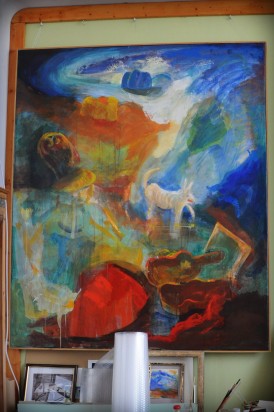Kéri Imre
 “It happened on a Saturday evening, in 1974. The neighbor rang on my door, only he had a phone line in the downtown blockhouse. He gabbled excitedly: “Go to the gallery, a bearded, two-meter long Italian, wearing Bermudas, wants to see you immediately.
“It happened on a Saturday evening, in 1974. The neighbor rang on my door, only he had a phone line in the downtown blockhouse. He gabbled excitedly: “Go to the gallery, a bearded, two-meter long Italian, wearing Bermudas, wants to see you immediately.
I’m not a man of compromise, I do not back my opinion, for this reason it was a sudden surprise that they allowed me to exhibit my twenty etchings at the famous Dürer Gallery. “European standard, indeed, what you did” — said Emilio Vedova, the grand master of painting and graphics, embracing my shoulder. He immediately bought ten prints of mine, although that day before the prices were deleted from the tags by a plainclothesman. The Comrade from the Ministry said: the Socialism keeps you live, there is no place for marketing! We had a dinner together with Master Vedova that evening. Strongly heated by wine, he drew something big on the napkin and cried: “The artist must be strong and red blooded!”. Thus began our friendship.
“Italy, as if my second homeland. I remember the pleasant encounters, amusing experiences, great miracles. In 1996 in the streets of Rome, wearing painty trousers and black T-shirt, you surely attract attention standing before a stretcher, a painting on it. At the Pantheon a little kid with school bag stops at me, rewieving the picture with frowned brows, then he comments ‘buen disegno’ (well done drawing) and runs away. Two young men, arm in arm, suddenly start to sing behind me. At the fish market the fishmonger sets the tuna, asking: ‘It is better, maestro, is not it?’ And in the third evening at dusk, returning home, the innkeeper prepares the red vine and sandwiches, welcoming me: ‘ You are surely hungry, maestro…’
At building this studio in 1914, there was a city decree: if the builder undertook himself to make a studio in the house, the building site was cheaper. The Ministry of Culture designated the artist-tenant; the rental fee went to the owner. Hundreds of studios were built in Budapest that time. This building was a boarding house.
We are in the loft. The large windows over the city excite the colors. To right, the colorful cavalcade of the Amsterdam jumble sale market invoke the hippie movement. His visit to Rembrand’s city was a real turning point in his ouvre. Returning home from the etching exhibition, organised for the 300th anniversary of the death of the famous Dutchman, effected by the renowned classic and inspirational Cobra Group, he never painted as before. For this reason, he was disgraced.
He was going to be a writer. In the sixties, in the Lipták house at Balatonfüred, he was sitting in the company of Passuth, Borsos, Illyés, all of famous artists, around the green-tiled stove.
He became a graphic artist of great stories, who is working with the rocker. For the fine tones of the mezzotints, you must roughen the copper plate with this tool. Others rarely cultivate this genre. You need a lot of patience and experience, just like for multicolor printing.
A personal copperplate machine was considered as a printing press in the sixties, to have it was illegal and, for this reason, dangerous. A latheman, an ironworker undertook to gather the parts and to build the press. The ironworker asked him: what was the engine for the press? He answered: “Well, it will be driven by bean soup and stew!”
23/12/2010 Budapest
www.keri-decsi.hu
________________________________________________________________________
2007-ben elfogadta az Európai Unió: a művészet munka!
PREVIOUS: Kelle Antal
NEXT: Tóth Ernő
















USER COMMENTS ( 0 )
Follow Comments via RSS feed. Trackback Comments from your website.